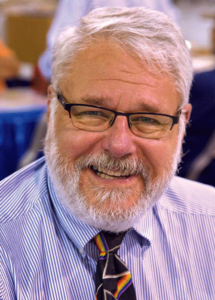 Well-known philatelic writer and editor Wayne Youngblood — and one of the most-popular people in U.S. stamp collecting — is the new editor of two top publications: American Stamp Dealer & Collector and Collectors Club Philatelist. The latter is published by the Collectors Club in New York City.
Well-known philatelic writer and editor Wayne Youngblood — and one of the most-popular people in U.S. stamp collecting — is the new editor of two top publications: American Stamp Dealer & Collector and Collectors Club Philatelist. The latter is published by the Collectors Club in New York City.
The former is a glossy magazine which, despite its title, is aimed at a more casual audience and possible news stand sales.
“I am thrilled for the opportunity and extremely indebted to current editors Randy Neil (who founded ASD&C) and Gene Fricks,” the current editor of the Collectors Club Philatelist, Youngblood posted on Facebook.
Said the American Stamp Dealers Association, publisher of ASD&C, in a press release, “Wayne’s reputation and accomplishments in the hobby make him the perfect choice to take the magazine into the future.
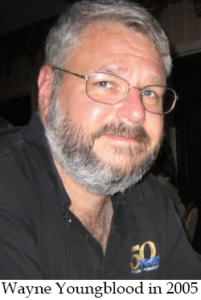 “Wayne, one of the most recognized names in the U.S. philatelic community, is a lifelong stamp collector who began before the age of 8 and never stopped. He has been an APS member for more than 40 years, serving nearly a decade on its board of directors. He also serves as an expertizer for American Philatelic Expertizing (for more than 25 years), and is the longest-term instructor at the APS Summer Seminar on Philately, where he has been lead instructor of the Stamp Technology course for more than 25 years.”
“Wayne, one of the most recognized names in the U.S. philatelic community, is a lifelong stamp collector who began before the age of 8 and never stopped. He has been an APS member for more than 40 years, serving nearly a decade on its board of directors. He also serves as an expertizer for American Philatelic Expertizing (for more than 25 years), and is the longest-term instructor at the APS Summer Seminar on Philately, where he has been lead instructor of the Stamp Technology course for more than 25 years.”
Youngblood was elected at the American Philatelic Society Board for the first time as a Director-at-Large in 1997 at the age of 35.
His philatelic writing career began as a staff editor for Linn’s Stamp News, then as Editor of the co-owned Scott Stamp Monthly. He later moved to the rival Stamp Collector newspaper, and became publisher of owner Krause Publications other hobby/collectible publications, ranging from comics and toys to records and movies.
Youngblood is the author of 10 books (including eight on history and historical photography) and has had thousands of articles published throughout the philatelic world.
He currently edits the American Topical Association’s Topical Time journal and Duck Tracks for the National Duck Stamp Collectors Society. He continues to write regularly for several publications (including American Philatelist, Linn’s and The international Philatelic Exporter) and is in-demand as a philatelic speaker.
In addition to belonging to numerous philatelic organizations, Youngblood serves on the board of directors of the Arizona Philatelic Rangers and has been inducted into the APS Writers Unit #30 Hall of Fame and the Wisconsin Federation of Stamp Clubs Hall of Fame. Although his primary expertise lies in stamps, Wayne, who is now an independent author, editor, and dealer, also has a strong interest and knowledge base in historical documents, autographs and vintage photographs. He has served at numerous appraisal fairs specializing in these areas for about 20 years.
Among his collecting interests are errors, freaks and oddities; fakes and forgeries; and the secret drop boxes of the Manhattan Project at Los Alamos.
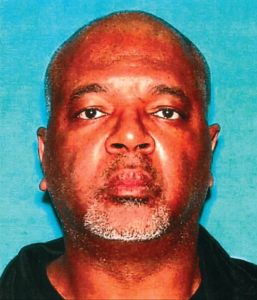 The October 27th Virtual Stamp Club radio feature was about one of the few African-American stamp dealers, Kevin Custis, whose day job was being a physician.
The October 27th Virtual Stamp Club radio feature was about one of the few African-American stamp dealers, Kevin Custis, whose day job was being a physician.
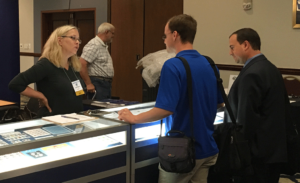 Jay Bigalke, editor of American Philatelist, the official journal of the American Philatelic Society, is leaving to return to his former employer and become Editor-in-Chief at Linn’s Stamp News.
Jay Bigalke, editor of American Philatelist, the official journal of the American Philatelic Society, is leaving to return to his former employer and become Editor-in-Chief at Linn’s Stamp News. 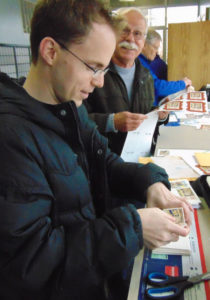 Bigalke became AP editor
Bigalke became AP editor Well-known philatelic writer and editor Wayne Youngblood — and one of the most-popular people in U.S. stamp collecting — is the new editor of two top publications: American Stamp Dealer & Collector and Collectors Club Philatelist. The latter is published by the Collectors Club in New York City.
Well-known philatelic writer and editor Wayne Youngblood — and one of the most-popular people in U.S. stamp collecting — is the new editor of two top publications: American Stamp Dealer & Collector and Collectors Club Philatelist. The latter is published by the Collectors Club in New York City. “Wayne, one of the most recognized names in the U.S. philatelic community, is a lifelong stamp collector who began before the age of 8 and never stopped. He has been an APS member for more than 40 years, serving nearly a decade on its board of directors. He also serves as an expertizer for American Philatelic Expertizing (for more than 25 years), and is the longest-term instructor at the APS Summer Seminar on Philately, where he has been lead instructor of the Stamp Technology course for more than 25 years.”
“Wayne, one of the most recognized names in the U.S. philatelic community, is a lifelong stamp collector who began before the age of 8 and never stopped. He has been an APS member for more than 40 years, serving nearly a decade on its board of directors. He also serves as an expertizer for American Philatelic Expertizing (for more than 25 years), and is the longest-term instructor at the APS Summer Seminar on Philately, where he has been lead instructor of the Stamp Technology course for more than 25 years.” At a “town hall” meeting at the NAPEX show in suburban Washington, D.C., June 9, 2017, American Philatelic Society executive director Scott English talked about the diminishing membership, not only in the APS, but in stamp collecting organizations in general.
At a “town hall” meeting at the NAPEX show in suburban Washington, D.C., June 9, 2017, American Philatelic Society executive director Scott English talked about the diminishing membership, not only in the APS, but in stamp collecting organizations in general.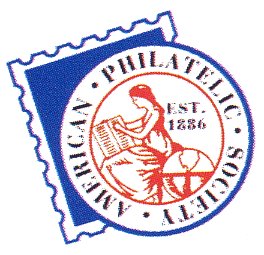 English told the collectors at the NAPEX session the APS may get involved in the Regency-Superior bankruptcy case. That was a large philatelic auction house and retail stamp seller with headquarters in Saint Louis. A major creditor has seized the assets of the firm, and those who consigned stamps and covers to Regency-Superior for sale may not be paid.
English told the collectors at the NAPEX session the APS may get involved in the Regency-Superior bankruptcy case. That was a large philatelic auction house and retail stamp seller with headquarters in Saint Louis. A major creditor has seized the assets of the firm, and those who consigned stamps and covers to Regency-Superior for sale may not be paid.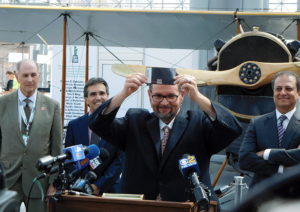 English gives “all credit” to Robert A. Siegel Auctions for getting the most possible for the American Philatelic Research Library for the recently-recovered inverted Jenny airmail stamp. “That stamp should have sold for about $180,000,” English said. “It’s probably the most expensive reperfed stamp ever!”
English gives “all credit” to Robert A. Siegel Auctions for getting the most possible for the American Philatelic Research Library for the recently-recovered inverted Jenny airmail stamp. “That stamp should have sold for about $180,000,” English said. “It’s probably the most expensive reperfed stamp ever!”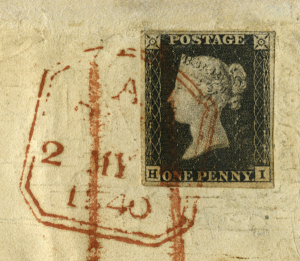 The world’s oldest stamp dealership, Stanley Gibbons, has put itself up for sale, according to a report by the
The world’s oldest stamp dealership, Stanley Gibbons, has put itself up for sale, according to a report by the 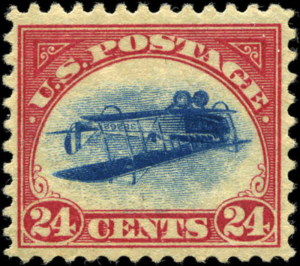 The Inverted Jenny stamp stolen in 1955 and
The Inverted Jenny stamp stolen in 1955 and 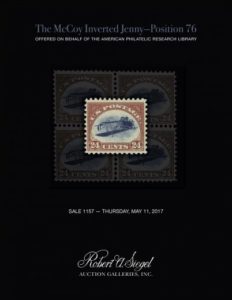 ition 76 was $150,000-$200,000, well below the final price. No doubt its notoriety added to the value.
ition 76 was $150,000-$200,000, well below the final price. No doubt its notoriety added to the value.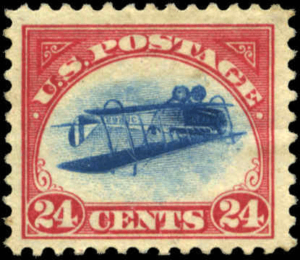 A representative of an auction firm recently brought a Jenny Invert to the Philatelic Foundation’s New York offices for authentication on behalf of a consignor. The Philatelic Foundation is widely regarded in the hobby of stamp collecting for its expertise in authenticating this iconic United States air mail rarity. Over the last 70 years, the PF has issued Certificates of Authenticity for 85 of the 100 stamps from the original error sheet of the “upside down airplane stamp,” including all six of the existing blocks of four.
A representative of an auction firm recently brought a Jenny Invert to the Philatelic Foundation’s New York offices for authentication on behalf of a consignor. The Philatelic Foundation is widely regarded in the hobby of stamp collecting for its expertise in authenticating this iconic United States air mail rarity. Over the last 70 years, the PF has issued Certificates of Authenticity for 85 of the 100 stamps from the original error sheet of the “upside down airplane stamp,” including all six of the existing blocks of four.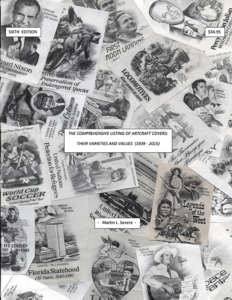 The Comprehensive Listing of ArtCraft Covers: Their Varieties and Values (1939-2015) is the Sixth (Compendium) Edition in this mammoth project which documents all known ArtCraft covers and varieties produced by the Washington Press (Washington Stamp Exchange). The Listing references over 15,000 collectibles, spanning the company’s full 76 years of production, and has been affectionately labeled “The ArtCraft Bible” by the active community of ArtCraft collectors worldwide.
The Comprehensive Listing of ArtCraft Covers: Their Varieties and Values (1939-2015) is the Sixth (Compendium) Edition in this mammoth project which documents all known ArtCraft covers and varieties produced by the Washington Press (Washington Stamp Exchange). The Listing references over 15,000 collectibles, spanning the company’s full 76 years of production, and has been affectionately labeled “The ArtCraft Bible” by the active community of ArtCraft collectors worldwide.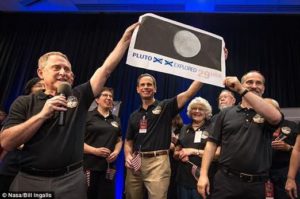 Some background from the USPS: A 1991 Pluto: Not Yet Explored stamp that traveled more than 3 billion miles on NASA’s New Horizons spacecraft to Pluto has earned the GUINNESS WORLD RECORDS™ achievement for the farthest distance traveled by a postage stamp.
Some background from the USPS: A 1991 Pluto: Not Yet Explored stamp that traveled more than 3 billion miles on NASA’s New Horizons spacecraft to Pluto has earned the GUINNESS WORLD RECORDS™ achievement for the farthest distance traveled by a postage stamp.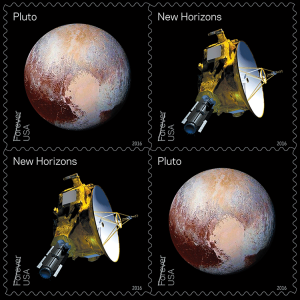 The Postal Service learned of the 29-cent stamp’s journey on the eve of the flyover and quickly put plans into place to set the record straight as noted in NASA’s celebratory photo above.
The Postal Service learned of the 29-cent stamp’s journey on the eve of the flyover and quickly put plans into place to set the record straight as noted in NASA’s celebratory photo above.

